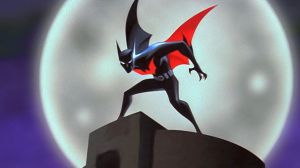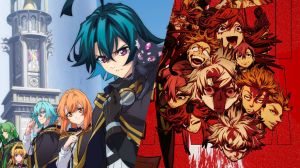Debuting on Fox Kids in the fall of 1992, Batman: The Animated Series was a seismic event in television animation. Developed by Bruce Timm, Paul Dini, and Eric Radomski, the series ran for 85 episodes across two seasons and immediately distinguished itself from its contemporaries with a mature tone and a striking visual style dubbed “dark deco” that would redefine how the broad public perceived Batman. In addition, the show garnered widespread critical acclaim, winning four Emmy Awards during its run for its groundbreaking writing. Finally, Batman: The Animated Series fundamentally contributed to the Batman canon, most famously by creating the character of Harley Quinn.
Videos by ComicBook.com
Batman: The Animated Series‘ sophisticated approach to character psychology, particularly with its villains, and its cinematic storytelling redefined what a superhero cartoon could be, creating what many still hold as the definitive version of the Dark Knight. That means choosing the best episodes of the series is an arduous task, as there’s arguably no bad episode in its entire run. Nevertheless, some chapters of Batman: The Animated Series still stand as some of the best animated episodes of all time. Here’s our pick for the 10 best episodes of Batman: The Animated Series.
NOTE: Batman: TAS had a lot of multi-episode arcs during its run, and for the purposes of this list, we’ll be treating them as one story.
1) “Feat of Clay, Parts I & II” (Season 1, Episodes 4 & 5)

The definitive origin of the villain Clayface is explored in the two-part episode “Feat of Clay.” Written by Marv Wolfman and Michael Reaves in “Part I”, with Paul Dini contributing to “Part II”, the story introduces Matt Hagen (voiced by Ron Perlman), a talented but disfigured actor who relies on a dangerously addictive cosmetic cream to restore his career. When crime boss Roland Daggett (voiced by Ed Asner) has his thugs force-feed Hagen a massive overdose of the substance, the actor is horrifically transformed into a shapeshifting monster of living clay.
“Feat of Clay” stands with “Heart of Ice” and “Two-Face” as a lesson in turning a classic villain into a sympathetic monster. The story functions as a powerful allegory for addiction and desperation, with Ron Perlman’s performance perfectly capturing Hagen’s pain and rage. Furthermore, the animation for Clayface’s transformations was groundbreaking for its time, presenting a level of body horror and fluidity that was startling for a children’s program. The narrative cements Clayface as a tragic figure, a man whose identity was stolen from him twice, first by an accident and then by his own vices. This episode is so iconic that Mike Flanagan has even taken inspiration from it for the DCU’s Clayface movie.
2) “Two-Face, Parts I & II” (Season 1, Episodes 10 & 11)

The episode “Two-Face, Parts I & II” focuses on District Attorney Harvey Dent (voiced by Richard Moll) and chronicles his fall from grace. Penned by Alan Burnett, part one establishes Dent as a close friend of Bruce Wayne (voiced by Kevin Conroy) and a crusading public servant. Crucially, the story introduces his struggle with a repressed alternate personality, “Big Bad Harv,” giving his character a deep psychological fragility long before his transformation. This narrative choice adds a layer of inevitability and tragedy to his eventual downfall.
The story climaxes when crime boss Rupert Thorne (voiced by John Vernon) uses Dent’s psychiatric records for blackmail, leading to a chemical plant explosion that horribly scars half of Dent’s face and unleashes his villainous persona. Part two follows Batman’s desperate attempts to reach the man still inside the monster, culminating in an emotional confrontation that forces the Dark Knight to his brink. While Christopher Nolan would retrace a similar path in The Dark Knight, Batman: The Animated Series laid the foundations for modern complex explorations of Two-Face’s psyche.
3) “Heart of Ice” (Season 1, Episode 14)
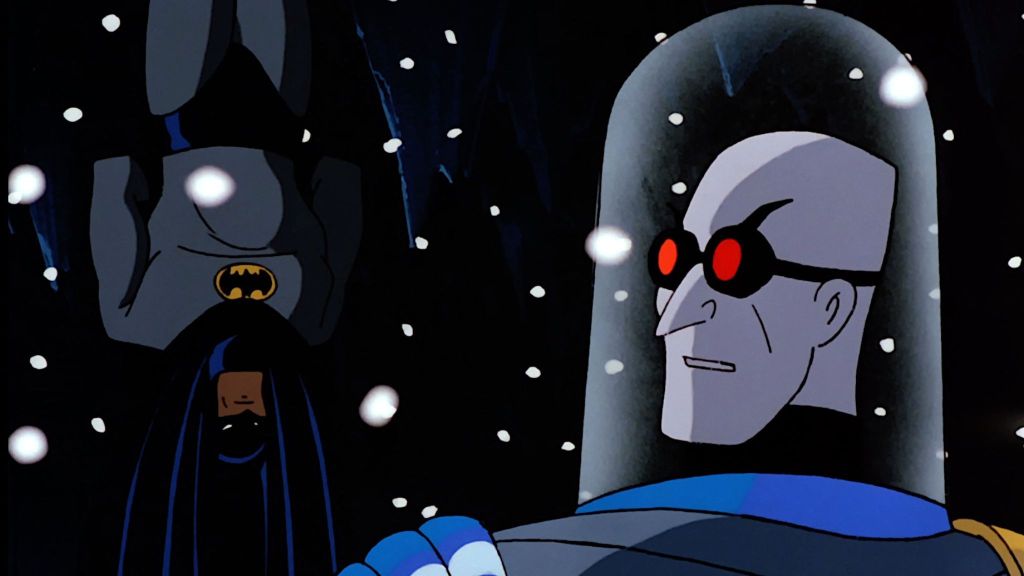
No single episode had a greater impact on DC Comics canon than “Heart of Ice.” Before this 1992 story from writer Paul Dini, Mr. Freeze was a C-list villain with an ice gun. The episode completely reinvented him as Dr. Victor Fries (voiced by Michael Ansara), a brilliant GothCorp scientist whose life is destroyed by the cruel indifference of his boss, CEO Ferris Boyle (voiced by Mark Hamill). A lab accident caused by Boyle’s interference mutates Fries, leaving him unable to survive above sub-zero temperatures, and seemingly dooms his terminally ill wife, Nora, whom he had cryogenically frozen. This gives him a powerful and sympathetic motivation for his crimes: passionate vengeance.
Mr. Freeze’s portrayal is brilliant, with Ansara’s cold delivery conveying immense pain through its very lack of emotion. Plus, the narrative brilliantly positions the charismatic Boyle as the true monster, forcing the audience to root for Fries. The episode’s critical acclaim, including a Daytime Emmy Award for Outstanding Writing, validated this mature approach to storytelling, helping Batman: The Animated Series to become the classic it now is. In addition, the success of this re-imagining was so absolute that DC Comics absorbed the origin wholesale into the main comic continuity, forever changing the character from a joke into a figure of Shakespearean tragedy.
4) “Beware the Gray Ghost” (Season 1, Episode 18)

“Beware the Gray Ghost” stands as a meta-textual tribute to the pulp heroes who inspired Batman. When a series of bombings in Gotham perfectly mimics the crimes of a villain from an old black-and-white television show, Batman seeks help from the show’s star, Simon Trent, now a washed-up actor who resents the heroic role that defined his career. In a brilliant stroke of casting, Trent is voiced by Adam West, the actor who famously portrayed Batman in the 1960s live-action series.
“Beware the Gray Ghost” works on multiple levels. It is a solid mystery, but its true strength is as a poignant and respectful examination of legacy. A key scene reveals that The Gray Ghost was Bruce Wayne’s childhood hero, the fictional character who inspired him to become a real one. This creates a powerful full-circle moment when Batman must convince a broken Trent to become the hero one last time to help save the city. The story is a touching homage to Adam West’s own complicated legacy and a statement on the power of fiction to inspire real-world heroism.
5) “I Am the Night” (Season 1, Episode 22)

The immense psychological weight of Bruce Wayne’s mission is confronted directly in “I Am the Night.” The story, written by Michael Reaves, opens on the grim anniversary of his parents’ murder, finding Batman in a state of exhaustion and doubt, questioning if his one-man war on crime is making any real difference. This internal crisis spirals into despair when Commissioner Gordon (voiced by Bob Hastings) is gravely wounded in a shootout, an event Batman believes he could have prevented had he not been delayed by his own brooding.
The episode’s focus is on Bruce’s internal state, featuring some of the most powerful character-driven scenes in the series, including a tense argument with a concerned Robin (voiced by Loren Lester) and a somber pilgrimage to Crime Alley. For one of the few times in the series, Batman is truly broken, ready to abandon his vow entirely until he embraces his calling once more. “I Am the Night” provides a rare look at the hero at his breaking point, reinforcing that his greatest strength is not his gadgets or his fists, but his incredible resilience in the face of utter hopelessness.
6) “Perchance to Dream” (Season 1, Episode 30)
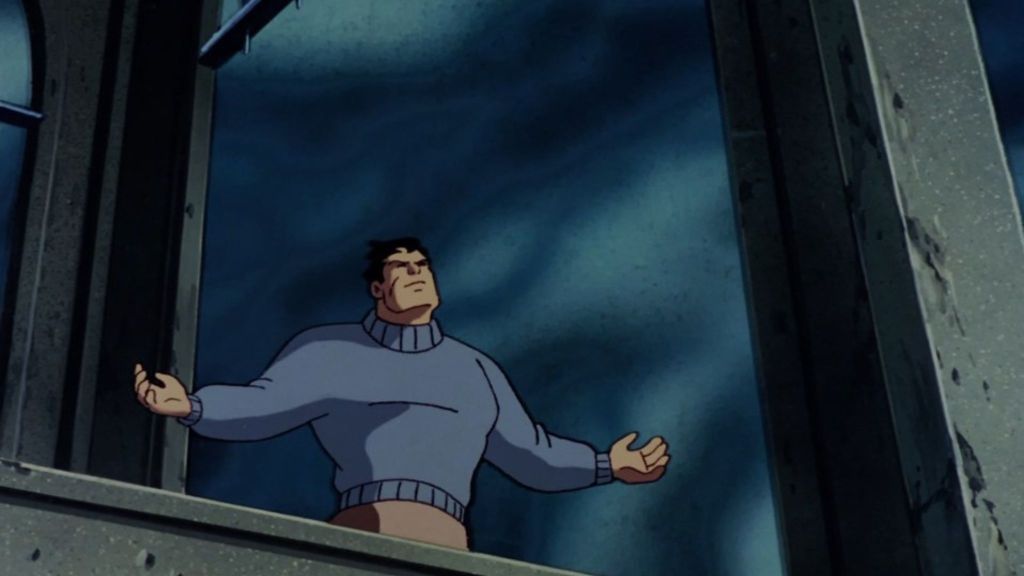
“Perchance to Dream” plunges both Batman and the audience into a deeply unsettling psychological thriller. After being knocked unconscious during a warehouse chase, Bruce Wayne awakens to a perfect life. His parents are alive and well, he is happily engaged to Selina Kyle (voiced by Adrienne Barbeau), and he never had to become Batman because someone else is already protecting Gotham. But a single, unnerving detail unravels this paradise: he cannot read any text. The words on every page are a jumbled, illegible mess, a clear sign that this reality is a sophisticated facade.
The realization that this elaborate fantasy is a prison created by the pathetic Mad Hatter (voiced by Roddy McDowall) is a gut punch. This narrative, from writers Laren Bright and Michael Reaves, forces Bruce to confront the life he was robbed of and then consciously choose to abandon it. To escape, Batman must take a leap of faith from a church tower, an act of symbolic suicide to kill the dream version of himself. The episode remains a smart exploration of the character’s core tragedy and the sacrifices inherent in his mission, making it essential viewing for Batman fans.
7) “Robin’s Reckoning, Parts I & II” (Season 1, Episodes 32 & 33)

The Emmy-winning “Robin’s Reckoning” illuminates the shared trauma that forged the unbreakable bond of the Dynamic Duo. When the man who murdered Dick Grayson’s parents, mobster Tony Zucco (voiced by Thomas F. Wilson), resurfaces after years in hiding, Batman benches his young partner, fearing that Robin’s righteous quest for vengeance will send him down the same dark and lonely path from which he himself has never returned. Based on this premise, the present-day hunt for Zucco is interwoven with cinematic flashbacks to the tragic death of the Flying Graysons at Haley’s Circus that underline Dick’s painful personal history.
“Robin’s Reckoning” is a masterwork of emotional storytelling, validating Robin’s place in the mythology by showing that his origin is just as defining as Batman’s. It also highlights the crucial difference between them. Bruce Wayne’s pain fuels an all-consuming obsession. His decision to take Dick in, however, allows his partner to find a path toward healing and justice, rather than pure vengeance. Finally, the story’s incredible depth, handled with maturity by writer Randy Rogel, solidifies their father-son dynamic as the true heart of Batman: The Animated Series.
8) “The Laughing Fish” (Season 1, Episode 34)

Adapting a classic 1970s comic storyline from creators Steve Englehart and Marshall Rogers, “The Laughing Fish” perfectly captures the terrifying unpredictability of the Joker (voiced by Mark Hamill). The episode’s bizarre premise involves the Joker poisoning Gotham’s fish, giving them his signature ghastly grin, and then attempting to copyright them. When a terrified patent clerk explains that he cannot copyright a natural resource, the Joker marks him for death at midnight, turning the absurd scheme into a tense race against time for Batman.
The episode excels at showcasing the core of the Joker’s character, blending his theatrical humor with a chilling disregard for human life. Plus, Hamill’s iconic voice work is at its peak, shifting from gleeful absurdity to genuine menace in an instant. The story also features a memorable appearance by Harley Quinn (voiced by Arleen Sorkin) and a fantastic action sequence where Batman must fight a shark in the Joker’s oversized aquarium. The faithful adaptation of iconic source material and its perfect distillation of the Joker’s unique brand of chaos make “The Laughing Fish” a definitive installment for the Clown Prince of Crime.
9) “Almost Got ‘Im” (Season 1, Episode 46)
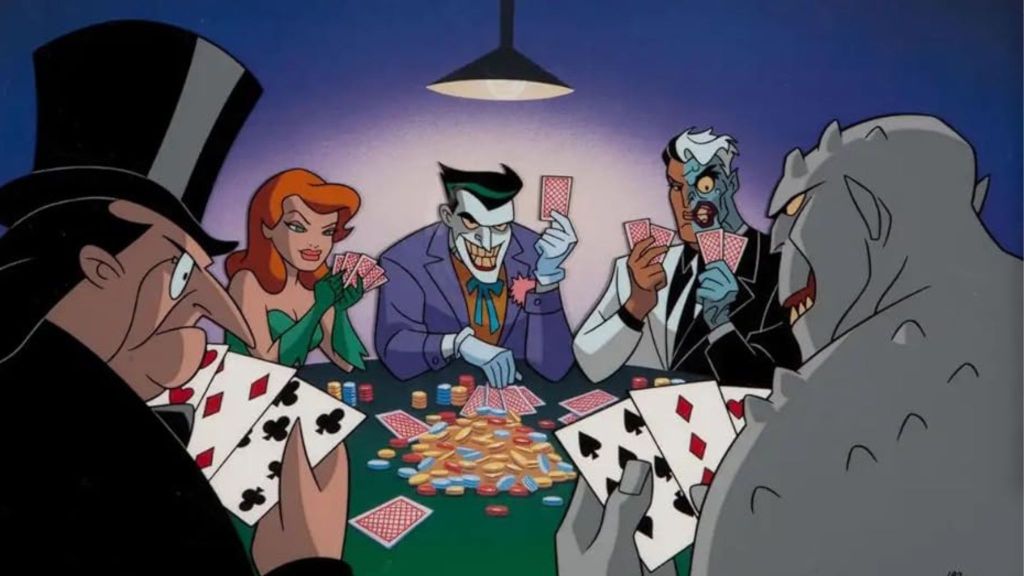
“Almost Got ‘Im” puts the villains squarely in the spotlight with its clever concept. The premise from writer Paul Dini finds Joker, Penguin (voiced by Paul Williams), Two-Face, Killer Croc (voiced by Aron Kincaid), and Poison Ivy (voiced by Diane Pershing) gathered for a game of poker, trading stories about the times they each came closest to killing Batman. This framing device allows the episode to unfold as an anthology of inventive short vignettes, each reflecting the personality of its narrator.
The strength of “Almost Got ‘Im” lies in its witty dialogue and the rare glimpse into the social dynamics of Gotham’s rogues’ gallery. The banter around the table provides excellent character moments, while each flashback is a fun self-contained adventure. The episode builds to a fantastic twist ending involving Catwoman (voiced by Adrienne Barbeau) that cleverly recontextualizes the entire story, reinforcing Batman’s status as a master strategist who is always one step ahead. Unsurprisingly, its unique villain-centric perspective and highly rewatchable structure make “Almost Got ‘Im” one of Batman: The Animated Series‘ most creative episodes.
10) “The Man Who Killed Batman” (Season 1, Episode 51)
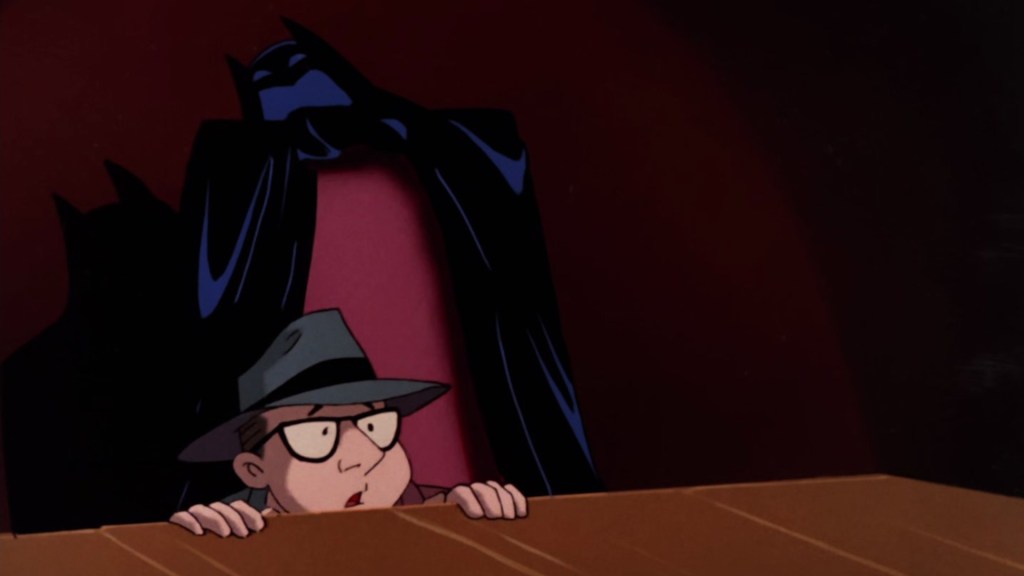
Written by Paul Dini, “The Man Who Killed Batman” examines a fascinating hypothetical: what would happen if a low-level nobody actually killed Batman? The story centers on Sidney Debris (voiced by Matt Frewer), a pathetic small-time hood who seemingly causes the Dark Knight’s death through a series of accidents during a rooftop chase. Instead of being hailed as a kingpin, Sid finds himself in even more trouble, as Gotham’s real villains refuse to believe that such a loser could accomplish a feat they never could.
The most brilliant part of the episode is its examination of the Joker’s reaction. Faced with the apparent loss of his nemesis, the clown is genuinely heartbroken and directionless. He even holds a funeral for Batman, delivering a surprisingly touching eulogy before trying to murder Sid for stealing his purpose. As a result, “The Man Who Killed Batman” is a darkly comedic and unexpectedly insightful look at the symbiotic nature of the hero-villain relationship, proving that Batman gives just as much meaning to his enemies’ lives as they give to his.
Which Batman: The Animated Series episode is your all-time favorite? Tell us in the comments!

